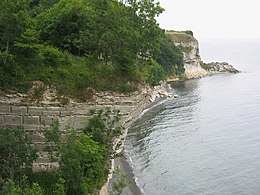Själland
| Native name: Sjælland | |
|---|---|

The Cliffs of Stevns south of Copenhagen
|
|
 |
|
| Geography | |
| Location | Baltic Sea |
| Coordinates | 55°30′N 11°45′E / 55.500°N 11.750°ECoordinates: 55°30′N 11°45′E / 55.500°N 11.750°E |
| Area | 7,031 km2 (2,715 sq mi) |
| Highest elevation | 126 m (413 ft) |
| Highest point | Unnamed |
| Administration | |
| Region | Capital Region of Denmark, Region Zealand |
| Largest settlement | Copenhagen (pop. 1,181,239) |
| Demographics | |
| Population | 2,267,659 |
| Pop. density | 354.3 /km2 (917.6 /sq mi) |
Zealand (Danish: Sjælland; pronounced [ˈɕɛˌlanˀ]), at 7,031 km2, is the largest (except Greenland) and most populated island in Denmark with a population of 2,267,659 (39% of Denmark's total as of January 2016).
It is the 96th-largest island in the world by area and the 35th most populous. It is connected to Funen by the Great Belt Fixed Link, to Lolland, Falster (and Germany from 2028) by the Storstrøm Bridge and the Farø Bridges. Zealand is also linked to Amager by five bridges. Zealand is linked indirectly, through intervening islands by a series of bridges and tunnels, to southern Sweden.
Copenhagen, the capital of Denmark, is located partly on the eastern shore of Zealand and partly on the island of Amager. Other cities on Zealand include Roskilde, Hillerød, Næstved and Helsingør. The island is not connected historically to the Pacific nation of New Zealand, which is named after the Dutch province of Zeeland.
In Norse mythology as told in the story of Gylfaginning, the island was created by the goddess Gefjun after she tricked Gylfi, the king of Sweden. She removed a piece of land and transported it to Denmark, which became Zealand. The vacant area was filled with water and became Mälaren. However, since modern maps show a similarity between Zealand and the Swedish lake Vänern, it is sometimes identified as the hole left by Gefjun.
...
Wikipedia
